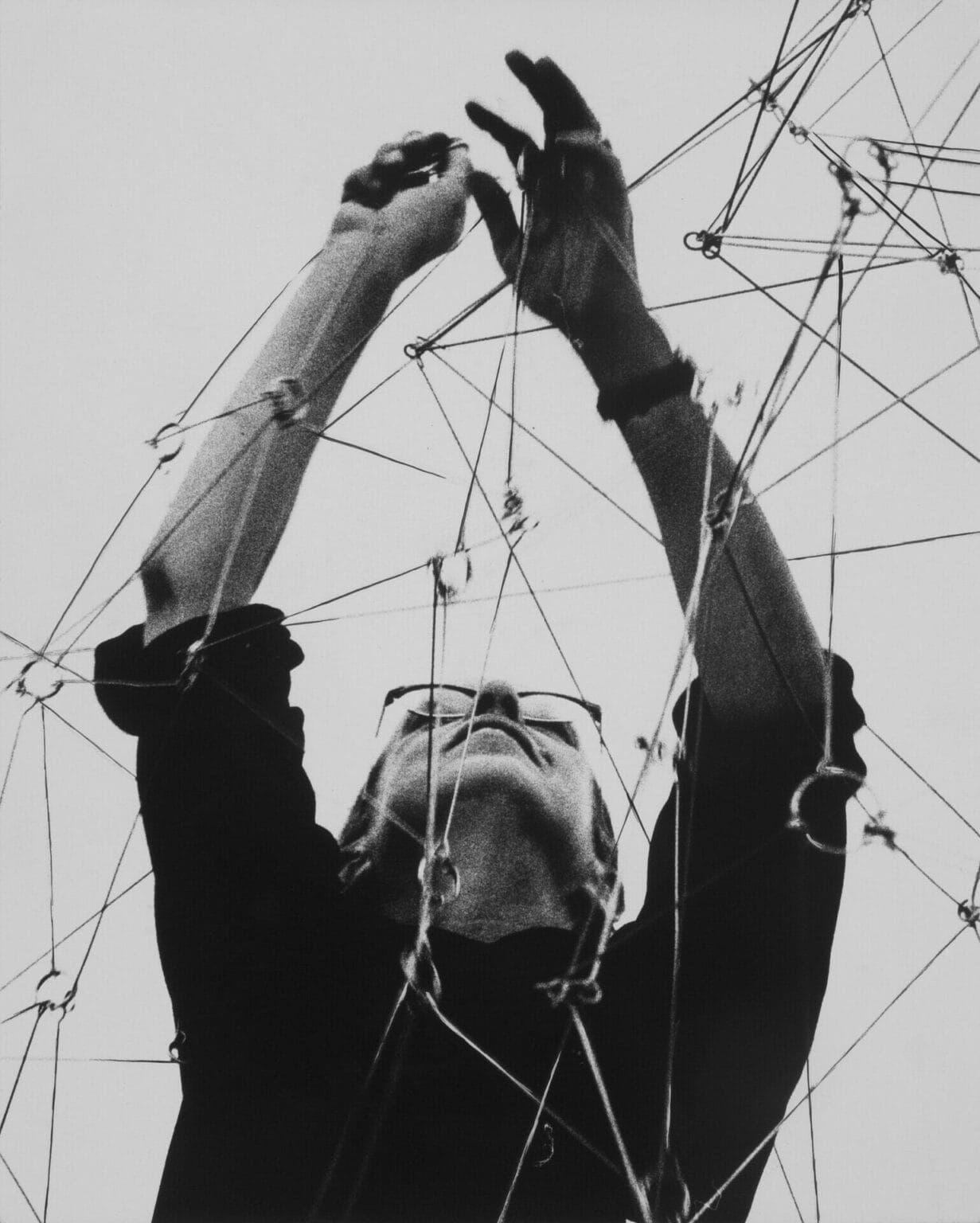The Guggenheim Museum Bilbao presents Gego. Measuring Infinity , a major retrospective offering a fully integrated view of the work by German-Venezuelan artist Gertrud Goldschmidt (b. 1912, Hamburg; d. 1994, Caracas), also known as Gego, and her distinctive approach to the language of abstraction. Sponsored by Seguros Bilbao (soon to become Occident) and arranged chronologically and thematically, the exhibition examines the artist’s formal and conceptual contributions through her organic forms, linear structures, and modular abstractions.
Nearly 150 works from the early 1950s through the early 1990s are featured including sculptures, drawings, prints, textiles, and artist’s books, alongside photographic images of installations and public artworks, sketches, publications, and letters. Situating Gego’s practice in the artistic contexts of Latin America that transpired over the course of her lengthy career, the survey also considers her intersections with—and departures from—key transnational art movements such as Geometric Abstraction and Kinetic Art.
Born into a German Jewish family, Gego first trained as an architect and engineer at the Technische Hochschule Stuttgart (now Universität Stuttgart). Fleeing Nazi persecution in 1939, she immigrated to Venezuela, where she settled permanently, and in 1953 embarked on an artistic career that would span more than four decades. In two- and three-dimensional works across a variety of mediums, the artist explored the relationship between line, space, and volume. Her engagements in the related fields of architecture, design, and education complemented those investigations.
Gego is one of the most significant artists to emerge from Latin America during the second half of the 20th century, and her career traced a markedly individual artistic path, which defied categorization. She put forth radical ideas through her investigations of structural systems: transparency, tension, fragility, spatial relations,
and the optical effects of motion are all methodically addressed in her singular body of work. This historical retrospective demonstrates the breadth of Gego’s multidisciplinary practice, advancing a deeper understanding and appreciation of the artist and her oeuvre in a global context.
The museum is thankful to Fundación Gego and its directors, Tomás Gunz and Barbara Gunz, as well as the foundation’s staff and Board, for their tremendous support and collaboration towards this exhibition.
TOUR OF THE EXHIBITION
Early Works (1951–55)
Venezuela experienced dramatic economic, political, and social changes during and after World War II. In 1939 the country was one of the world’s leading oil exporters and its third largest producer. A booming oil industry coupled with economic assistance from the United States enabled Venezuela to finance its own modernization in the postwar period. During this era Venezuelan modern art underwent an equally transformative shift. The emergence of Geometric Abstraction—a transnational movement characterized by pure form, line, color, and geometric ordering schemes—in the country around the 1950s marked a period of great artistic innovation. It was in this context that Gego began her new life in her adopted home of Venezuela. She began doing freelance work at architecture firms and city planning studios in Caracas in the early 1940s, utilizing the architectural and engineering training she had received in Germany. By the early 1950s, however, Gego
abandoned her architecture practice and fully embraced art-making. She relocated to the village of Tarmas, near Venezuela’s Caribbean coast, and concentrated in creating landscapes, depictions of architectural forms, and figuration, some of which are on view in this section.
Parallel Lines (1957–67)
Developing an artistic practice in her adopted country, Gego engaged the concepts of Venezuelan Geometric Abstraction, characterized by pure form, line, color, and geometric ordering schemes. She did the same with Cinetismo, a nationalized art movement that arose in the 1960s and drew upon the fundamental concepts of Kinetic Art (from the greek “kinesis,” meaning motion).
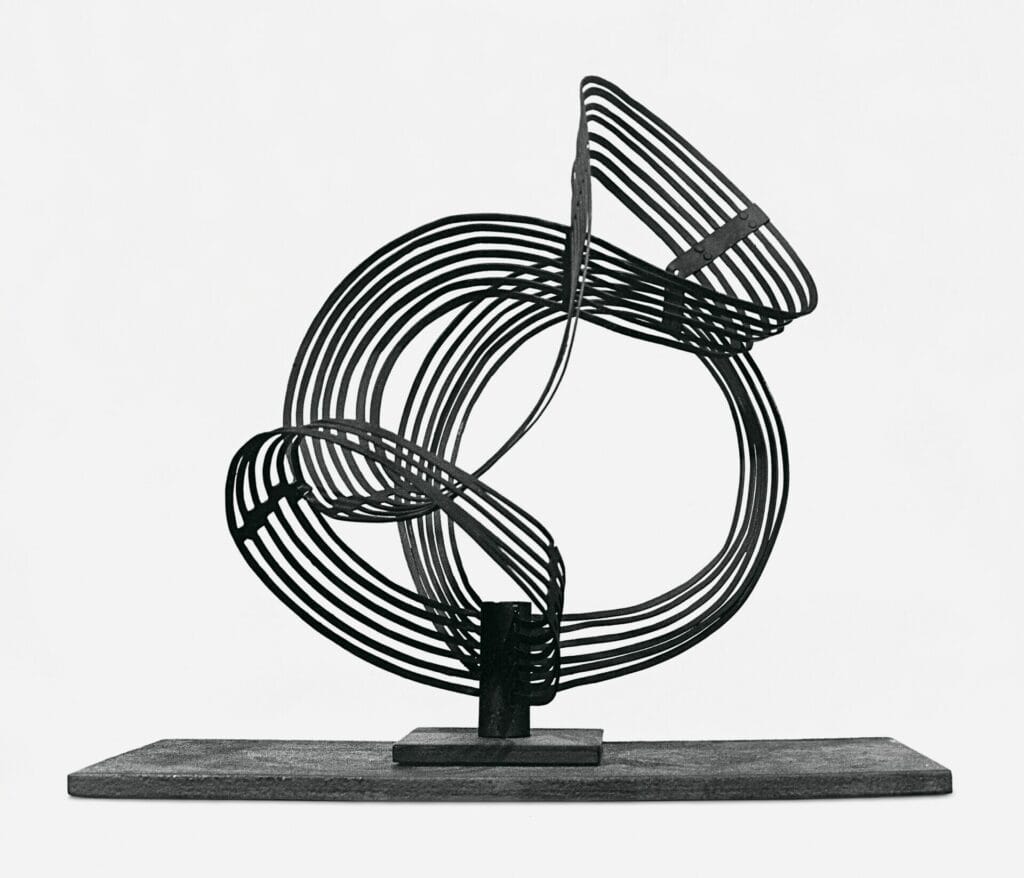
12 Concentric Circles (12 círculos concéntricos), 1957
Aluminum and paint
37 x 29 x 24 cm, incl. base
Private collection, Austin
© Fundación Gego
Photo: Tasnadi, Courtesy Archivo Fundación Gego
This selection of works on paper and sculptures from 1957-67 in this section considers Gego’s investigations of the spatial and structural possibilities of what she called “líneas paralelas” (parallel lines). Here, Gego’s use of lines, at times compressed, and at other times free, anchor her synthetic thinking of “the nothing between the
lines,” which became fundamental to her quest of making the “invisible, visible,” as seen in the untitled drawings of 1957 and 1964. Around 1960 Gego also began experimenting with the optical effects of motion and vibration, synthesizing her explorations of light, movement, and space—all prevalent themes in Kinetic Art. Some of the sculptures on view in this section, mostly welded, painted iron works, feature parallel tubular elements that form intersecting or superimposed geometric planes, such as 12 círculos concéntricos (12 Concentric Circles, 1957), and Cuatro planos rojos (Four Red Planes, 1967). As one engages with these works from different perspectives, the optical illusion of vibration and movement is produced, thus changing the perception of the objects themselves.

Untitled, 1958
Ink on paper
21.6 x 14.3 cm
MACBA Collection, MACBA Consortium, Long-term loan of Fundación Gego
© Fundación Gego
Photo: PhotoGasull, Courtesy MACBA Museu d’Art Contemporani de Barcelona
Tamarind Lithography Workshop and reticular studies (1963–70)
The works presented in this section embody Gego’s milestone developments from 1963 to 1970. The 1960s, in particular, brought much change to her experiments across various mediums. While Gego had first visited the United States in 1959, her travels there became more frequent. She received invitations, in 1963 and again in 1966, to attend the Tamarind Lithography Workshop in Los Angeles, where she produced a robust compilation of prints and artist’s books, such as Sin título (Tamarind 1843IV) (Untitled [Tamarind 1843IV]), and Sin título (Tamarind 1848B) (Untitled [Tamarind 1848B]), both from 1966. The selection on view here provides
a sense of Gego’s evolving inquiries into line, form, and space, and her use of new techniques and materials. Experimenting with embossing, engraving, etching, and lithography, the artist became an expert printmaker during this period.

Four Red Planes (Cuatro planos rojos), 1967
Iron and paint
84 × 90 × 84 cm
Colección Patricia Phelps de Cisneros
© Fundación Gego
Photo: Courtesy Colección Patricia Phelps de Cisneros
At the cusp of a new decade, in 1969, Gego made a decisive shift from “líneas paralelas” (parallel lines) to “reticuláreas,” her term for the various reticular forms (nets or net-like structures), in her two- and threedimensional production. The untitled drawings on view in this section from 1969-70 were made by Gego during a period of intensive study and experimentation with the design of reticular forms. Rendered in ink on paper, these abstract compositions comprise interconnected geometric shapes, such as triangles and squares, that collectively generate the impression of an undulating mesh or web.
Chorros, Troncos, Esferas, and reticular typologies (1969–88)
On view in this section is a selection of Gego’s hanging sculptures from 1969-88 that epitomizes the notion of “a measured infinity,” a poetic oxymoron that was eloquently penned by Venezuelan poet Alfredo Silva Estrada in his poem, “Variaciones sobre reticuláreas” (Variations on Reticuláreas, 1979), in homage to Gego. Mirroring the artist’s experiments with structure, space, light, shadow, line, and grid, the poem interprets infinite space as a finite, bounded element, making a symbolic attempt at measuring infinity through Gego’s forms themselves. Yet such an act is a paradox, for unbounded space and time are inherently immeasurable.
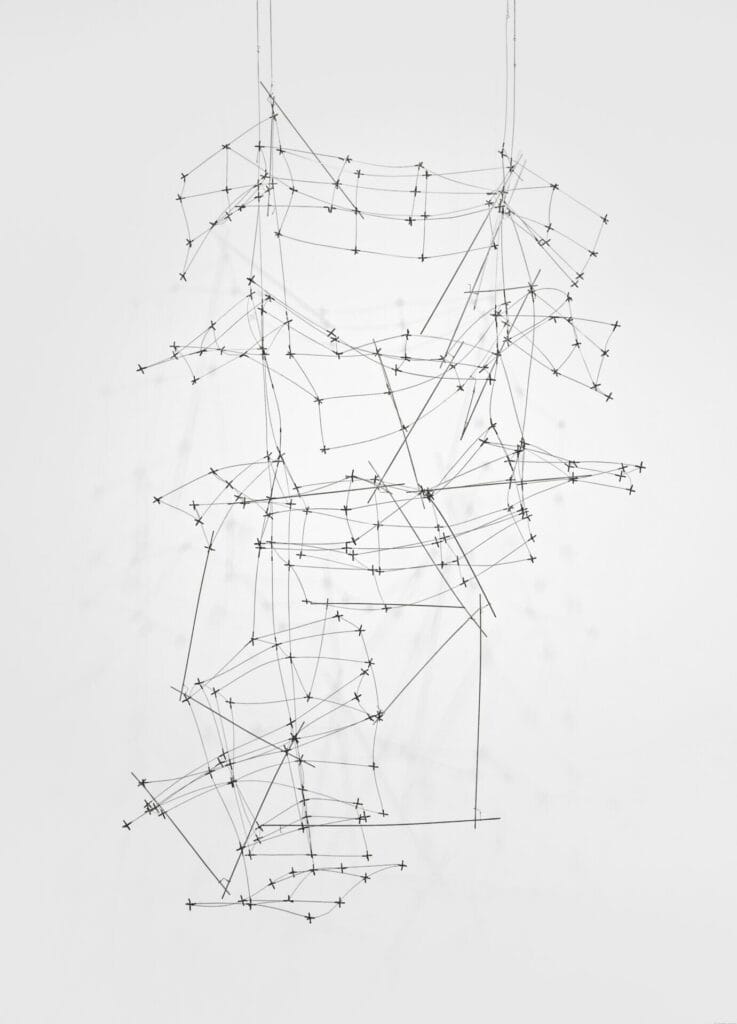
Column (Columna), 1972
Steel, aluminum, and copper
229.8 × 140.1 × 149.9 cm
The Ella Fontanals-Cisneros Collection, Miami
© Fundación Gego
Photo: Oriol Tarridas, Courtesy CIFO Cisneros Fontanals Art Foundation
Visitors are free to explore examples from three relevant series in this area: Chorros (Streams, 1970–74), Troncos (Trunks, 1974–81), and Esferas (Spheres, 1976–77). Suspended vertically in a large, central space in the gallery, these minimal works emphasize the themes of fragility, gravity, and transparency and further offer a means to understand the artist’s evolving formal developments.

Stream Reticulárea (Chorro Reticulárea), 1988
Steel
200 x 100 x 70 cm
Colección Mercantil, Caracas
© Fundación Gego
Photo: Walter Otto, Courtesy Colección Mercantil, Caracas
Additionally, other works from Gego’s hanging reticular typologies, or “reticuláreas,” as she referred to the nets or net-like forms based on the square or the triangle, are also included in this section, such as Sin título (Untitled, 1969), Columna (Column, 1972), Reticulárea cuadrada (Square Reticulárea, 1977), and Chorro Reticulárea (Stream Reticulárea , 1988), composed of reticular metal meshes that evoke constellations of lines woven across space when shown together.
Textiles (1956–88)
Gego’s interest in the concept and act of weaving permeated her artistic language. In the 1940s, after immigrating from Germany to Venezuela, Gego opened up a orkshop to design furniture, lamps, and rugs, among other things. At different moments during the 1970s and 1980s, she experimented again with rug designs and textiles that feature intricate woven patterns.
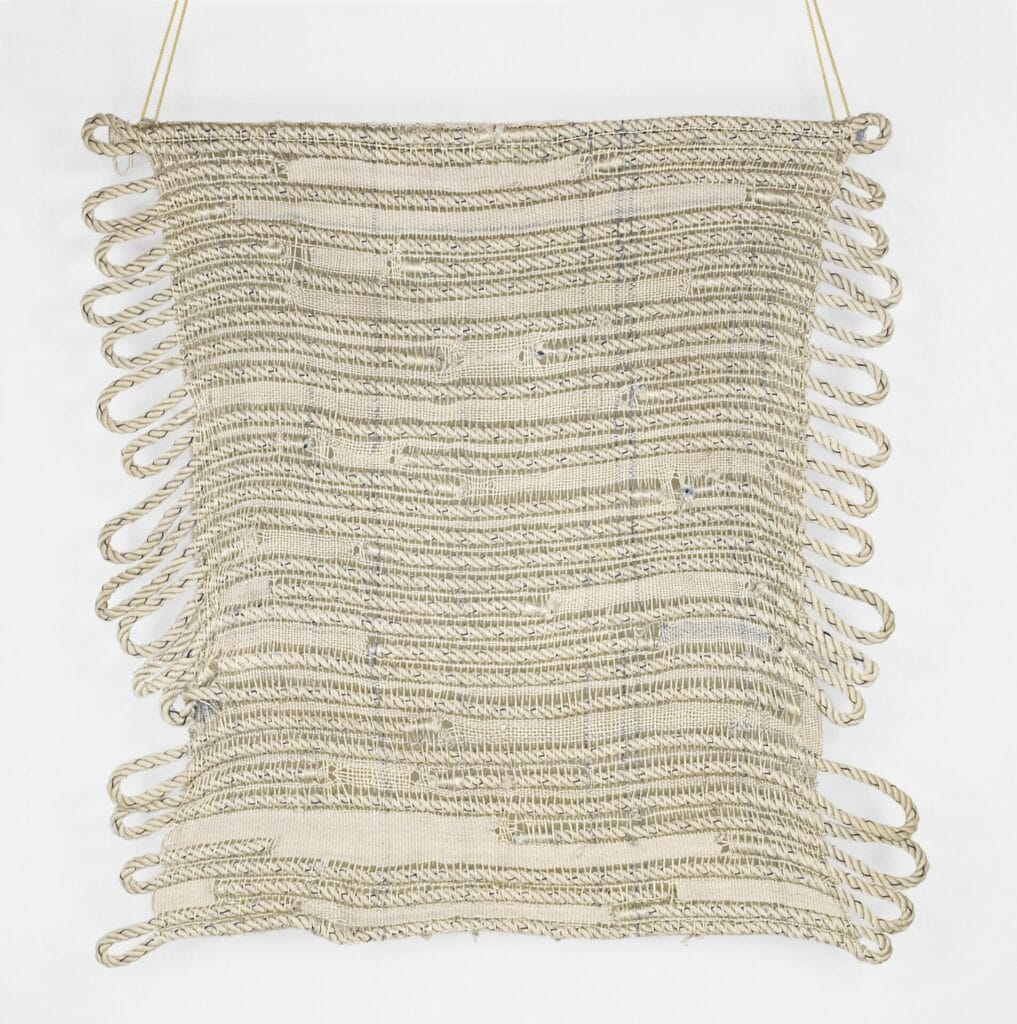
Untitled, ca. 1987
Synthetic fiber and wood
200 × 201 × 4 cm
Fundación Gego Collection, Caracas
© Fundación Gego
Photo: Reinaldo Armas Ponce, Courtesy Archivo Fundación Gego
The works on view in this section represent a return to the applied arts. In particular, Gego’s large-scale, hanging untitled tapestry created circa 1987, which is an exemplary work of the time. The textile consists of interlaced cords of synthetic fiber that run across the composition in parallel and loop at opposite ends, yielding a woven surface that is, at intervals, translucent. The wall-hung work exemplifies Gego’s use of linear elements, here in rope form, to generate abstract patterning.
Dibujos sin papel (ca. 1976–88)
The Dibujos sin papel (Drawings without Paper, ca. 1976–88) series, by far one of Gego’s more conceptually complex bodies of work, marked a crucial turning point in her artistic evolution. Made from wire, recycled metal scraps, and small pieces of hardware, these minimal sculptures hang from the ceiling or wall, as if drawn onto the vertical surface and into space, and function as paperless and frameless constructions.

Drawing without Paper (Dibujo sin papel), 1985
Iron and paint
63 × 54.5 × 21 cm
Private collection
© Fundación Gego
Photo: Barbara Brändli
On view in this section is a selection of works from this series, which offered the artist infinite possibilities for modulating space. She also challenged the autonomy of sculpture by subordinating the work to the wall, thereby ascribing the two-dimensional qualities of drawing to three-dimensional forms.

Drawing without Paper 86/14 (Dibujo sin papel 86/14), 1986
Aluminum, steel, iron, copper, plastic, and paint
68.5 x 31.5 x 3.3 cm
Fundación Gego Collection at the Museum of Fine Arts, Houston
© Fundación Gego
Photo: Thomas R. DuBrock, Courtesy The Museum of Fine Arts, Houston
Some early examples feature arrangements of planes that project outward, while others are structured around simple vertical or horizontal lines, or crisscross patterns. By 1979 these works began to take the form of empty square or rectangular frames. In the early 1980s Gego began including circular structures made with linear meshes, thread, and wire. From 1984 onward her focus shifted to representations of deformed or broken grids—geometric compositions of interrupted or unfinished linear patterns. In her later Dibujos sin papel , Gego gravitated toward a smaller scale and eliminated any type of frame structure, instead generating frayed, zigzagging linear configurations with eccentric geometric compositions.
Last Works: Tejeduras , Bichos and Bichitos (1987–91)
In the late 1980s Gego developed three final series: Tejeduras (Weavings, 1988-91), Bichos (Bugs, ca. 1987–91), and Bichitos (Small Bugs, 1987–89). Gego returned to making works on paper as her age progressively prevented her from manipulating metal and other rigid materials. Her Tejeduras are small-scale, twodimensional works made from interwoven strips of paper whose sources include printed images of her own works, pages from magazines, and commercial leaflets. Considered in the context of the artist’s longstanding interest with weaving, knotting, and netting, this late series ultimately synthesizes the formal and conceptual methodologies that structure Gego’s artistic idiom.

Small Bug 89/22 (Bichito 89/22), 1989
Iron, copper, plastic, and paint
13.5 x 9.5 x 9 cm
MACBA Collection, MACBA Consortium, Long-term loan of Fundación Gego
© Fundación Gego
Photo: PhotoGasull, Courtesy MACBA Museu d’Art Contemporani de Barcelona
Lastly, Gego’s two final sculptural series, Bichos and Bichitos , represent a total collapse and deformation of geometry, form, and the grid in the artist’s work. In Venezuelan usage bicho means animal, critter, or, most commonly, bug. It can also mean anything that does not have a specific name. With their precarious system of
construction, the Bichos and Bichitos are realized with repurposed materials and other elements discarded from other works by the artist. Gego devised these chaotic assemblages with unpredictable configurations characterized by diverse shapes and textures, thus freeing herself from fixed, rigid forms and giving preference to irregular and organic structures.
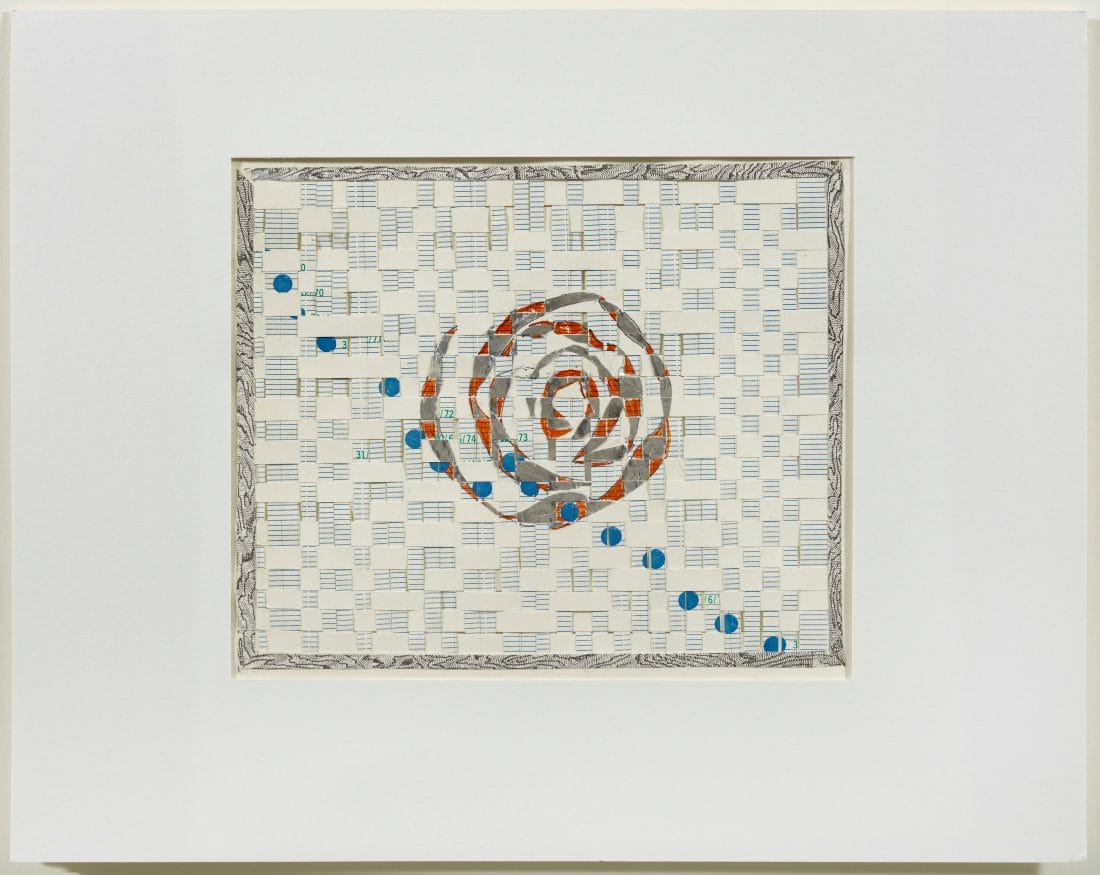
Untitled, ca. 1991
Paper, cardboard, and ink
17,6 x 21 cm
MACBA Collection, MACBA Consortium, Long-term loan of Fundación Gego
© Fundación Gego
Photo: PhotoGasull, MACBA Museu d’Art Contemporani de Barcelona
Gego. Measuring Infinity is organized by the Guggenheim Museum Bilbao in collaboration with the Solomon R. Guggenheim Museum, New York; Museo Jumex, Mexico City; and Museu de Arte de São Paulo Assis Chateaubriand–MASP.
The exhibition was developed by Julieta González, Artistic Director, Instituto Inhotim, Brumadinho, Brazil; Geaninne Gutiérrez-Guimarães, Associate Curator, Guggenheim Museum Bilbao, and Solomon R. Guggenheim Museum and Foundation, New York; and Pablo León de la Barra, Curator at Large, Latin America, Solomon R. Guggenheim Museum and Foundation, New York; in collaboration with Tanya Barson, former Chief Curator, Museu d’Art Contemporani de Barcelona, and Michael Wellen, Senior Curator, International Art, Tate Modern, London.
